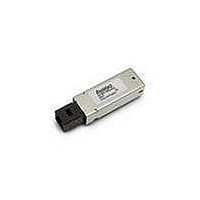AFBR-5903EZ Avago Technologies US Inc., AFBR-5903EZ Datasheet - Page 6

AFBR-5903EZ
Manufacturer Part Number
AFBR-5903EZ
Description
TXRX ETHERNET 125MBD MMF 2X5
Manufacturer
Avago Technologies US Inc.
Datasheet
1.AFBR-5903AZ.pdf
(16 pages)
Specifications of AFBR-5903EZ
Data Rate
100Mbps
Wavelength
1308nm
Applications
Ethernet
Voltage - Supply
3.135 V ~ 3.465 V
Connector Type
MTRJ
Mounting Type
Through Hole
Function
Implement FDDI and ATM at the 100 Mbps/125 MBd rate
Product
Transceiver
Maximum Rise Time
3 ns/2.2 ns
Maximum Fall Time
3 ns/2.2 ns
Pulse Width Distortion
0.12 ns/0.2 ns
Maximum Output Current
50 mA
Operating Supply Voltage
3.135 V to 3.465 V
Maximum Operating Temperature
+ 70 C
Minimum Operating Temperature
0 C
Package / Case
DIP With Connector
Lead Free Status / RoHS Status
Lead free / RoHS Compliant
For Use With
Multimode Glass
Lead Free Status / RoHS Status
Lead free / RoHS Compliant, Lead free / RoHS Compliant
Available stocks
Company
Part Number
Manufacturer
Quantity
Price
Company:
Part Number:
AFBR-5903EZ
Manufacturer:
Avago Technologies
Quantity:
135
Transceiver Signaling Operating Rate Range and BER
Performance
For purposes of definition, the symbol (Baud) rate, also
called signaling rate, is the reciprocal of the shortest
symbol time. Data rate (bits/sec) is the symbol rate di-
vided by the encoding factor used to encode the data
(symbols/bit).
When used in FDDI and ATM 100 Mb/s applications the
performance of the 1300 nm transceivers is guaranteed
over the signaling rate of 10 MBd to 125 MBd to the full con-
ditions listed in individual product specification tables.
The transceivers may be used for other applications at
signaling rates outside of the 10 MBd to 125 MBd range
with some penalty in the link optical power budget pri-
marily caused by a reduction of receiver sensitivity. Figure
5 gives an indication of the typical performance of these
1300 nm products at different rates.
These transceivers can also be used for applications which
require different Bit Error Rate (BER) performance. Figure
6 illustrates the typical trade-off between link BER and the
receivers input optical power level.
Transceiver Jitter Performance
The A vago T echnologies 1 300 n m t ransceivers a re d esigned
to operate per the system jitter allocations stated in Table
E1 of Annex E of the FDDI PMD and LCF-PMD standards.
The Avago T echnologies 1300 nm transmitters will tolerate
the worst case input electrical jitter allowed in these tables
without violating the worst case output jitter requirements
of Sections 8.1 Active Output Interface of the FDDI PMD
and LCF-PMD standards.
The Avago T echnologies 1300 nm receivers will tolerate the
worst case input optical jitter allowed in Sections 8.2 Active
Input Interface of the FDDI PMD and LCF-PMD standards
without violating the worst case output electrical jitter
allowed in Table E1 of Annex E.
The jitter specifications stated in the following 1300 nm
transceiver specification tables are derived from the values
in Table E1 of Annex E. They represent the worst case jitter
contribution that the transceivers are allowed to make
to the overall system jitter without violating the Annex E
allocation example. In practice the typical contribution of
the Avago Technologies transceivers is well below these
maximum allowed amounts.
Recommended Handling Precautions
Avago Technologies recommends that normal static
precautions be taken in the handling and assem-
bly of these transceivers to prevent damage which
may be induced by electrostatic discharge (ESD).
The AFBR-5903Z series of transceivers meet MIL-STD-883C
Method 3015.4 Class 2 products.
6
Care should be used to avoid shorting the receiver data or
signal detect outputs directly to ground without proper
current limiting impedance.
Solder and Wash Process Compatibility
The transceivers are delivered with protective process
plugs inserted into the MT-RJ connector receptacle. This
process plug protects the optical subassemblies during
wave solder and aqueous wash processing and acts as a
dust cover during shipping.
These transceivers are compatible with either industry
standard wave or hand solder processes.
Shipping Container
The transceiver is packaged in a shipping container de-
signed to protect it from mechanical and ESD damage
during shipment or storage.
Figure 6. Bit Error Rate vs. Relative Receiver Input Optical Power.
Figure 5. Transceiver Relative Optical Power Budget at Constant BER vs.
Signaling Rate.
1 x 10 -2
1 x 10 -3
1 x 10 -4
1 x 10 -5
1 x 10 -6
1 x 10 -7
1 x 10 -8
1 x 10 -9
1 x 10 -10
1 x 10 -11
1 x 10 -12
-0.5
2.5
1.5
0.5
-1
2
1
0
0
6. INPUT OPTICAL RISE/FALL TIMES = 1.0/ 2.1 ns.
CONDITIONS:
1. PRBS 2 7 -1
2. DATA SAMPLED AT CENTER OF DATA SYMBOL.
3. BER = 10 -6
4. T A = +25 ˚C
5. V CC = 3.3 V dc
-6
CONDITIONS:
1. 125 MBd
2. PRBS 2
3. CENTER OF SYMBOL SAMPLING
4. T
5. V
6. INPUT OPTICAL RISE/FALL TIMES = 1.0/ 2.1 ns.
25
RELATIVE INPUT OPTICAL POWER - dB
A
CC
= +25 ˚C
= 3.3 V dc
50
-4
7
SIGNAL RATE (MBd)
-1
75
-2
100
HFBR-5903 SERIES
125
CENTER OF SYMBOL
0
150
175
2
200
4

























